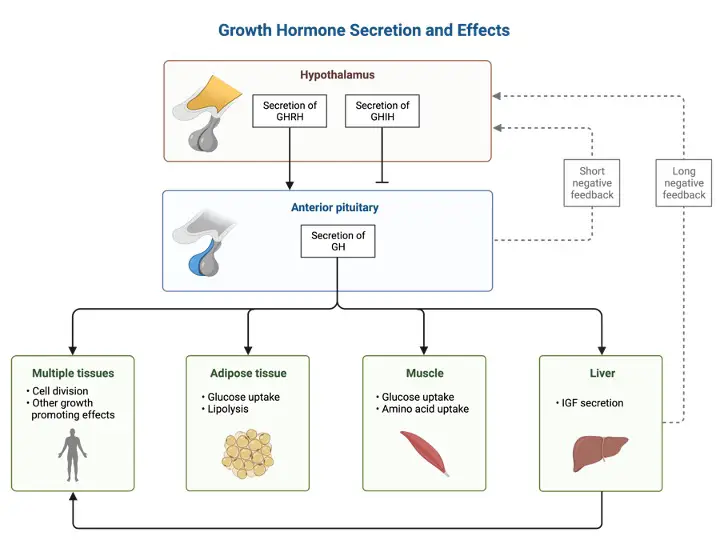Table of Contents
Growth Hormones
The endocrine glands of animals generate hormones. Although some hormones are generated directly in response to environmental cues, many are controlled by pituitary and hypothalamic hormones. Hormones that control animal development will be the subject of this session.
Types of Growth Hormones
i. Somatotropin
The pituitary gland is in charge of producing a hormone known as somatotropin. Somatotropin stimulates protein synthesis in all parts of the body, particularly cartilage, bone, and muscle. The anterior pituitary produces growth hormone under the direction of the hypothalamic growth hormone-releasing hormone (GHRH).

Somatotropin boosts protein synthesis by boosting amino acid absorption from meals, lowering protein degradation, and accelerating protein synthesis. Somatotropin also promotes protein synthesis by boosting fat metabolism and glucose release from the liver, as well as stimulating the production of another growth-promoting hormone, insulin-like growth factor (IGF-1).
IGF-1 promotes development by promoting the reproduction of cartilage cells, which occur before bone formation, and myoblasts, which produce muscle tissue. Somatotropin is inhibited by somatostatin, a hypothalamic hormone that inhibits somatotropin from being released from the pituitary. IGF-1 stimulates the secretion of somatostatin via feeding back to the hypothalamus.
Ghrelin, a stomach hormone, promotes the production of somatotropin. Interactions between environmental cues, like food intake, and developmental signals from the brain balance growth.
Bones appear to be permanent structures, yet even after the growing areas of the bone have been closed, they are continually rebuilt. Bones can be reshaped in response to movement-related stresses and to heal mild stress injuries.
ii. Thyroxine
Thyroxine, which is generated by the thyroid gland, is in charge of regulating the body’s metabolic rate and, as a result, the quantity of energy eaten and protein produced. Normal thyroid function is required for development, although it does not stimulate it directly. Thyroid-stimulating hormone (TSH) from the anterior pituitary gland stimulates thyroxine production, which is then triggered by thyrotropin-releasing hormone (TRH) from the brain.
iii. Testosterone and Oestrogen
In humans, the steroid sex hormones testosterone and oestrogen have a role in growth regulation. Both boys and females have a growth spurt throughout adolescence as a result of the hormone surge. Sex hormones, ironically, both accelerate and inhibit bone development in puberty by replacing cartilage in the growth zones with bone.
Growth Hormones Disorders
Somatotropin overproduction can lead to gigantism, whereas underproduction can lead to dwarfism. Acromegaly is a disease in which a person’s jaws, hands, and feet grow abnormally large as a result of excessive production of the chemical during maturity.
Growth Hormones Citations
- Human growth hormone. Pharmacol Rev . 1994 Mar;46(1):1-34.
- Diagnosis of growth hormone deficiency in the paediatric and transitional age. Best Pract Res Clin Endocrinol Metab . 2016 Dec;30(6):737-747.
- Growth Hormone(s), Testosterone, Insulin-Like Growth Factors, and Cortisol: Roles and Integration for Cellular Development and Growth With Exercise. Front Endocrinol (Lausanne) . 2020 Feb 25;11:33.
- Figures are created with BioRender.com







